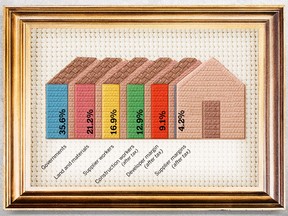World
Canada’s Housing Crisis: Short-Term Thinking Fuels Long-Term Struggles

OTTAWA — Canada’s housing market is in a state of crisis, with many prospective buyers, like a 32-year-old financial professional named Eddie, struggling to find homes that meet their needs within a reasonable budget. Despite a six-figure salary and additional income from rental properties, Eddie has spent over seven months searching for a home in Ottawa, willing to pay up to $900,000 for a property with a backyard and three bedrooms. The frustration he faces reflects a broader issue affecting countless Canadians, particularly in urban areas where housing affordability has deteriorated significantly.
The crux of the problem lies in a severe shortage of housing supply, which analysts attribute to a combination of rising taxes, zoning regulations, and bureaucratic hurdles at various government levels. According to experts, these factors have created a significant barrier to new home construction, ultimately driving up prices and limiting options for buyers and renters alike.
Government Initiatives and Industry Challenges
In response to the growing housing crisis, the federal government recently announced the Build Canada Homes program, a $13 billion initiative aimed at accelerating the construction of affordable homes for middle- and lower-income Canadians. Prime Minister Mark Carney emphasized that the program will provide financial incentives to attract private investments and facilitate the construction of 4,000 factory-built homes on federal land across six cities. This initiative aims to increase housing production to 500,000 units annually over the next decade.
While some industry leaders have welcomed these developments, there is skepticism regarding their immediate impact. The Canadian Home Builders’ Association has criticized the creation of additional federal entities, arguing that bureaucratic expansion complicates an already intricate process. Conservative Leader Pierre Poilievre echoed these concerns, suggesting that instead of alleviating the crisis, the government has added layers of bureaucracy.
Moreover, local governments, often seen as the most critical players in the housing landscape, face their own challenges. They control zoning and land-use regulations and are responsible for essential services required for new developments. The rising costs of development charges, which increased by approximately 65 percent between 2020 and 2024, have only exacerbated the affordability crisis. According to Paul Smetanin, an economist with the Canadian Centre for Economic Analysis, these charges disproportionately affect buyers of lower-priced homes, making it harder for them to enter the market.
Long-Term Solutions Needed
As the federal government and provinces implement various strategies to address the housing shortage, the consensus is clear: solving the crisis will require a long-term, coordinated effort. The Canada Mortgage and Housing Corporation has projected that housing starts will decrease to 237,800 this year, down from 245,367 in 2024, with a further decline anticipated in subsequent years. This trend highlights the ongoing supply-demand imbalance that continues to drive prices skyward.
Economists argue that the core of the crisis stems from years of neglect regarding infrastructure investment and housing development. The average purchase price of a new home in Canada has now reached approximately $1.07 million, a reflection of the persistent demand fueled by population growth and limited supply.
To achieve the ambitious goal of constructing 500,000 homes annually, all levels of government will need to work collaboratively to streamline processes, reduce development charges, and invest in necessary infrastructure. As Eddie’s experience illustrates, the existing systems are failing to provide adequate housing options, leaving many Canadians feeling disillusioned and priced out of the market.
Addressing the housing crisis in Canada is not just a matter of policy; it is a critical social issue affecting the well-being and stability of families across the country. The path to resolution will require patience and commitment from all stakeholders, as the effects of short-term thinking in housing policy have created a complex problem that cannot be solved overnight.
-

 Science2 months ago
Science2 months agoToyoake City Proposes Daily Two-Hour Smartphone Use Limit
-

 Health2 months ago
Health2 months agoB.C. Review Reveals Urgent Need for Rare-Disease Drug Reforms
-

 Top Stories2 months ago
Top Stories2 months agoPedestrian Fatally Injured in Esquimalt Collision on August 14
-

 Technology2 months ago
Technology2 months agoDark Adventure Game “Bye Sweet Carole” Set for October Release
-

 World2 months ago
World2 months agoJimmy Lai’s Defense Challenges Charges Under National Security Law
-

 Technology2 months ago
Technology2 months agoKonami Revives Iconic Metal Gear Solid Delta Ahead of Release
-

 Technology2 months ago
Technology2 months agoSnapmaker U1 Color 3D Printer Redefines Speed and Sustainability
-

 Technology2 months ago
Technology2 months agoAION Folding Knife: Redefining EDC Design with Premium Materials
-

 Technology2 months ago
Technology2 months agoSolve Today’s Wordle Challenge: Hints and Answer for August 19
-

 Business2 months ago
Business2 months agoGordon Murray Automotive Unveils S1 LM and Le Mans GTR at Monterey
-

 Lifestyle2 months ago
Lifestyle2 months agoVictoria’s Pop-Up Shop Shines Light on B.C.’s Wolf Cull
-

 Technology2 months ago
Technology2 months agoApple Expands Self-Service Repair Program to Canada









